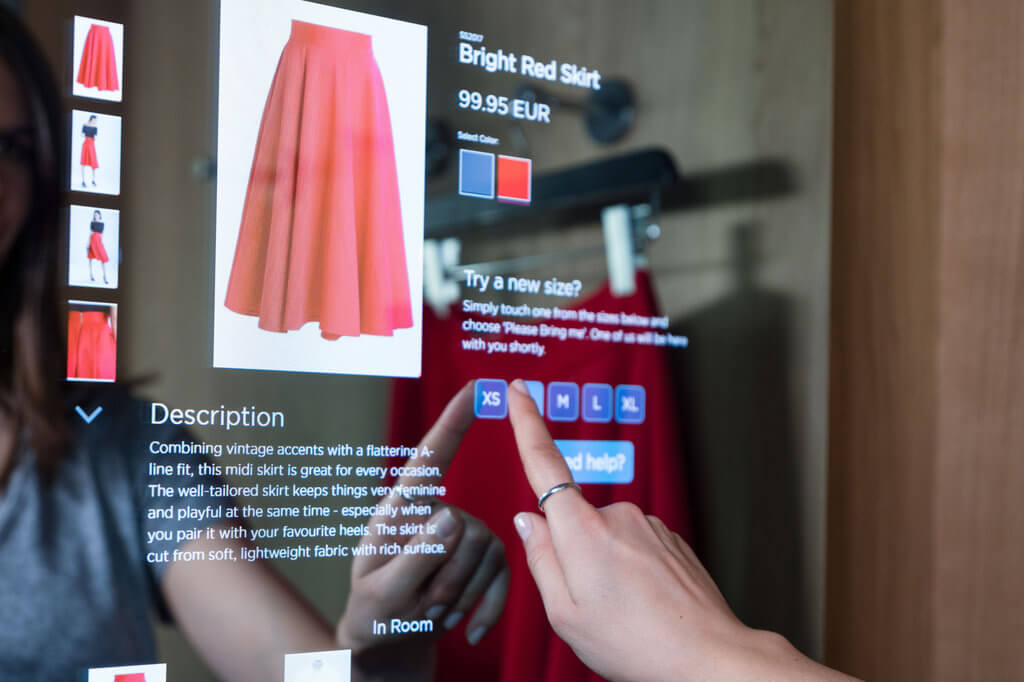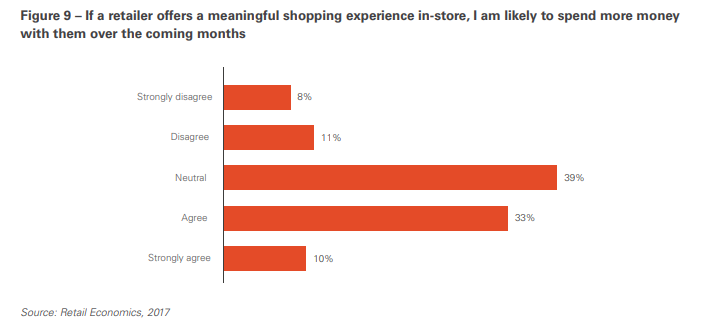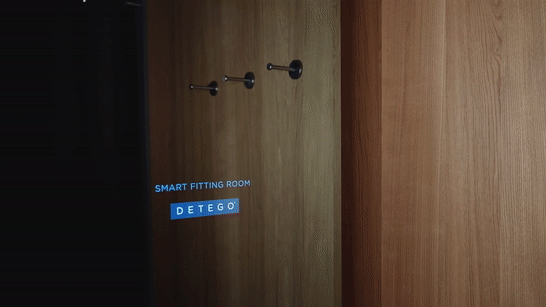Smart Fitting Rooms are finally live in the retail market. So what exactly are they, what do they do, and what kind of value do they add to retail business?
Just smoke and mirrors? Breaking down the business case of Smart Fitting Rooms

What is a Smart Fitting Room?
Smart fitting rooms consist of an interactive touch-screen mirror connected to an RFID reader and a motion sensor. They sense when customers enter the fitting room, and sense what items they have brought in with them by reading their RFID tags. They then assist the customer throughout the fitting room process, giving them information on products and calling for assistance if required. In simple terms, they allow consumers to experience the same benefits they get from online shopping whilst in the fitting room, as well as let them request items be brought directly to them.
What does a Smart fitting room do?
- Detect movement and presence of a customer
- Identifies which item the customer brings to try on
- Displays additional product information
- Provides availability information to the consumer
- Shows product recommendations that would complement the currently selected style
- Provides additional services such as Call for Assistance or Call for different products / colors / sizes
Smart fitting rooms have existed in the fringes of the retail technology space for a number of years. The interactive mirrors certainly capture the imagination, but they’ve only really existed at trade shows and in concept stores rather than out in the wild. It’s fair to say the technology was in the category of interesting and fun but not really taken seriously. Fast forward to 2020, and we have just seen the first major commercial use of smart fitting rooms, in a truly digital, experience-first, award-winning store.
What makes up a Smart Fitting Room?
- Framed Mirror
- RFID Reader & Antennas
- Motion Sensor
- Touchscreen Display
- Internet Connection
- A store that is using RFID item-level tagging
So, now is the time to start paying attention to Smart Fitting Rooms. But for those looking at the technology, either for the first time or with fresh interest now that solutions are live in the market, the business case might be a concern. In this article, we will break down exactly what a smart fitting can do, and what kind of value they offer for retailers, customers and retail profits.
What are the business benefits of Smart Fitting Rooms?
Improving Customer Experience
As a customer-facing technology, we’ll start with the most obvious (yet qualitative) use of the smart fitting room – an improved customer experience.
Rather than taking this for granted, however, let’s dig into how, why and even if smart fitting rooms offer a better experience for customers. Having a mirror automatically detect and display item information is nice and will wow customers (at least to begin with) but doesn’t really add much more value than an interactive screen that can scan products barcodes or even a product QR code.
What sets smart fitting rooms apart from these solutions are the interactive options and how they support customers. This includes offering additional and related or ‘frequently bought together’ items, information on exactly what is available in the store (using the real-time stock view RFID provides) as well as being able to request items be brought directly to the fitting room. These options being built directly into the mirror that customers already use will both delight customers and make the fitting room experience more convenient.
How smart fitting rooms benefit the customer:
- Shows different product combinations
- Makes product recommendations
- Article availability check
- Shows full range of articles to browse through
- Additional information, videos, social media integration
- Customer-friendly fitting (Article-Bring-Service)
- Enables digitally supported purchase decisions
- Direct reservation or ordering of articles
- Different delivery options (delivery to home address, from another store, etc.)
The economic value of customer experience:
Increase Sales
‘Customer experience is king’ has been a favourite tagline of innovative retail for some time. While it’s probably true and certainly sounds good, when it comes to the business case of new technologies you really do need to look at revenue. In terms of the customer, that generally means sales. So, what effect do smart fitting rooms have on sales? Other than more tenuous effects like bringing more customers in to the store, Smart fitting rooms increase retail sales in two ways:
Combating Lost Sales
Fitting room conversions is a self-explanatory if unfamiliar term for brick and mortar stores. That’s because as a KPI retailers have never had any way to measure or track this (more on this later). But fitting rooms are absolutely pivotal to apparel sales.
According to The Retail Doctor, shoppers who use dressing rooms are 70% more likely to buy versus those who don’t. It’s easy to see why, as customers have already decided that they like the item and want to purchase it, so fitting rooms become a question of making sure, and finding the right size.
It’s finding the correct size where most fitting rooms sales are lost. If a customer needs a different size, they will have to leave the fitting room and come back. Studies prove that this can have a major impact on sales, as 50% and 21% of people say they will sometimes and every time respectively leave the fitting room and the store if they were looking for assistance to change colour or size of an item and can’t find anyone.
This is why helpful fitting rooms assistants have such a big impact on sales, customers who receive assistance in fitting rooms make twice as many purchases as those who don’t. Smart fitting rooms address this issue, showing customers what other sizes are available and letting them request different sizes be brought directly to them. This allows stores to have assistance on hand (they are notified via a mobile application) without needing a permanent fitting rooms assistant, which is not feasible for many stores.
Increasing basket size with in-store cross-selling
The other sales driver of smart fitting rooms is having product recommendations made based on the items brought into the fitting room. This brings cross-selling common in e-commerce to the brick and mortar experience. Whilst these can be done as an endless aisle (so the entire product range of a store) the better way is to only offer items that are available in the store (using the stock visibility RFID provides). Much like requesting additional sizes, customers can request to have items that catch their eye brought directly to them. This can drive sales significantly and has been seen to increase fitting rooms basket size by 100% in initial studies.
New Data and Insights For Stores
The lesser-known use case of smart fitting rooms is the data and insight provided about the customer experience. It’s often said that compared to e-commerce, retailers have next to no data about what actually happens inside their stores. Other than what gets sold, they’re blind. In an industry as competitive and fast-moving as retail, this lack of analytics can be fatal.
We’ve already established how important fitting rooms are to apparel sales, so it seems that collecting and analysing data from them is a no-brainer. Traditionally however this hasn’t been the case, but with RFID and smart fitting rooms, retailers can collect that data in a non-invasive way.
What kind of insights are provided by smart fitting rooms?
- Item Conversion rate – How often are items selling (or not selling) immediately after being tried on in a fitting room?
- Fitting baskets vs shopping baskets – Most tried on vs most sold
- Number of items per session
- Session duration
- Recommendation conversion rate – How often are items recommended, requested and then sold?
- Need assistance use – How often are staff called to the fitting room using the mirror?
- Staff response time – How long does it take for store staff to react to customer requests? (gaining actionable insight to customer experience)
Conclusion
Consider the context of interactive displays, AR, VR and even RFID tables. Smart fitting rooms are both a part of this space and completely apart from it. This is because fitting rooms aren’t new, they are and always will be a part of the apparel shopping experience. Rather than adding a new element to the shopping experience like VR for example, smart fitting rooms are improving an integral (and for many, unpleasant) part of the customer experience.
In other words – it’s an evolution, not a revolution.
Whether retailers embrace this evolution will be decided in the coming years, now that smart fitting rooms are finally out in the wild. Perhaps even more crucially, especially when talking about business case, now smart fitting rooms are out in the market we will begin to see data and results that will prove the value once and for all. As early innovators of the technology, we can’t wait.






Leave a Reply